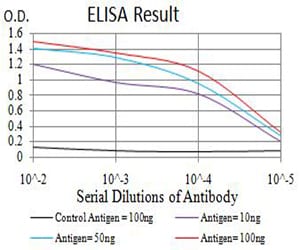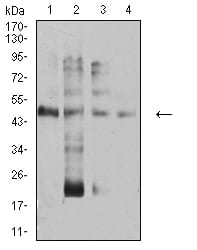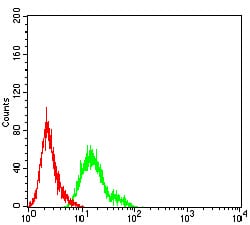


| WB | 咨询技术 | Human,Mouse,Rat |
| IF | 咨询技术 | Human,Mouse,Rat |
| IHC | 咨询技术 | Human,Mouse,Rat |
| ICC | 技术咨询 | Human,Mouse,Rat |
| FCM | 1/200 - 1/400 | Human,Mouse,Rat |
| Elisa | 1/10000 | Human,Mouse,Rat |
| Aliases | AP-2; BOFS; AP2TF; TFAP2; AP-2alpha |
| Entrez GeneID | 7020 |
| clone | 2H9F12 |
| WB Predicted band size | 48kDa |
| Host/Isotype | Mouse IgG1 |
| Antibody Type | Primary antibody |
| Storage | Store at 4°C short term. Aliquot and store at -20°C long term. Avoid freeze/thaw cycles. |
| Species Reactivity | Human,Mouse |
| Immunogen | Purified recombinant fragment of human TFAP2A (AA: 105-211) expressed in E. Coli. |
| Formulation | Purified antibody in PBS with 0.05% sodium azide |
+ +
以下是3篇与TFAP2A抗体相关的参考文献,按文献名称、作者及摘要内容简要整理:
---
1. **"TFAP2A is a critical regulator of secretory differentiation in breast cancer"**
*作者:Berger et al. (2021)*
**摘要**:该研究利用TFAP2A特异性抗体(克隆号:6H8)通过免疫组化分析乳腺癌组织,发现TFAP2A通过调控分泌相关基因(如MMP2、KLK6)促进肿瘤分泌表型,提示其可作为治疗靶点。
---
2. **"Immunohistochemical detection of AP-2α in human tissues using a monoclonal antibody"**
*作者:Williams et al. (2003)*
**摘要**:首次报道了一种针对TFAP2A(AP-2α)的小鼠单克隆抗体的开发与验证,通过Western blot和免疫荧光证实其在胚胎及成人组织中特异性识别TFAP2A蛋白,适用于病理诊断与基础研究。
---
3. **"AP-2α regulates SOSTDC1 in oral squamous cell carcinoma"**
*作者:Li et al. (2018)*
**摘要**:研究使用抗TFAP2A抗体(货号:ab108311)进行ChIP-seq分析,揭示TFAP2A通过结合SOSTDC1基因启动子抑制口腔鳞癌侵袭,为TFAP2A的抑癌机制提供新证据。
---
如需更详细文献信息或扩展检索范围,可补充说明具体需求。
The TFAP2A antibody is a crucial tool in molecular and cellular biology research, targeting the transcription factor AP-2α encoded by the TFAP2A gene. AP-2α belongs to the AP-2 family of transcription factors, which regulate gene expression during embryonic development, cell differentiation, and tissue homeostasis. Structurally, AP-2α contains a conserved helix-span-helix dimerization domain and a basic DNA-binding region, enabling it to bind specific DNA sequences (GC-rich motifs) and activate or repress target genes involved in cell proliferation, apoptosis, and carcinogenesis.
This antibody is widely used to investigate AP-2α's role in developmental disorders and cancers, including breast cancer, melanoma, and neuroblastoma. Studies highlight its dual oncogenic or tumor-suppressive functions depending on tissue context. In diagnostics, TFAP2A expression levels, detected via Western blotting, immunohistochemistry (IHC), or immunofluorescence (IF), serve as potential biomarkers for disease progression or therapeutic targeting.
Commercial TFAP2A antibodies are typically raised in rabbits or mice against epitopes within the N-terminal or C-terminal regions. Validation often includes knockout (KO) cell lines to confirm specificity. Researchers must consider cross-reactivity with other AP-2 family members (e.g., AP-2β, AP-2γ) and optimize protocols for specific applications. Its utility extends to chromatin immunoprecipitation (ChIP) for mapping DNA-binding sites and studying gene regulatory networks. Overall, the TFAP2A antibody is indispensable for unraveling the protein's multifaceted roles in development and disease.
×